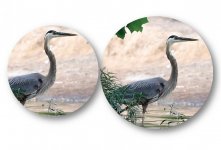Lately I have been using my kowa bd II 6.5x32 quite a bit and I am enjoying its easy eye placement with 5mm exit pupil, great depth of field, bright view and wide field, etc. When ever I compare it to an 8x32, I struggle to see any benefit from the extra magnification ie. I don't find I am able to see that much more detail. Of course, these are only hand held comparisons and not mounted on a tri-pod. A good example was just yesterday when I observed a merlin perched high up on a tree from approximately 150 feet away. If I compare to a 12x binocular then I am able to see more detail, although it becomes more challenging hand holding a 12.
I'm just wondering if anyone else has compared a 6-7x binocular against an 8 and feel the same way? If so, my next question is why do so many people gravitate to an 8 power binocular? Is it simply because there is so much selection out there in this power in the marketplace?
I'm just wondering if anyone else has compared a 6-7x binocular against an 8 and feel the same way? If so, my next question is why do so many people gravitate to an 8 power binocular? Is it simply because there is so much selection out there in this power in the marketplace?








